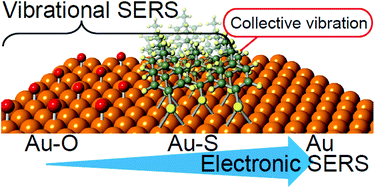In situ surface-enhanced electronic and vibrational Raman scattering spectroscopy at metal/molecule interfaces†
Abstract
SERS signals from nanostructured surfaces of Au, covered with thiol monolayers, were monitored under application of various electrochemical potentials over a wide Raman-shift range of both the Stokes and anti-Stokes branches. The background continuum in the SERS spectra varied in intensity with apparent correlations with breaking of Au–S bond or evolution of Au–O. This clearly indicates that the origin of the background can be ascribed to non-resonant electronic Raman scattering, which is sensitive to the electronic density at the surface. Using the property of the electronic Raman scattering, full information on the electric double layer at both sides of the metal/dielectric interface was analysed. In the low Raman-shift region below 200 cm−1, moreover, the evolution and disappearance of collective motions of thiol assembly was able to be monitored in situ, which is hardly obtainable with other vibrational absorption spectroscopies.

- This article is part of the themed collection: Advances in Plasmonics and Its Applications


 Please wait while we load your content...
Please wait while we load your content...